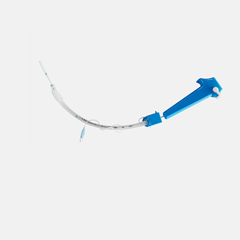A piece of string, a $1 spring and some 3-D-printed plastic – it doesn’t sound like much. Yet, two U of T students brilliantly combined these items to make a prototype for a new tracheal intubation guide system for difficult intubation patients that would cost less than $20.
It’s an innovative design that has netted its creators, Qian (Linda) Liu (BASc 2013) and Kaiyin (Cathy) Zhu (BASc 2013) this year’s John W. Senders Award for Imaginative Design from the Faculty of Applied Science and Engineering.
Tracheal intubation is the placement of a flexible plastic tube into someone’s windpipe (the trachea) to ensure the patient can continue to breathe. Intubation is often needed in the operating room and in high-risk situations in emergency wards or intensive care units. But if the procedure is not done properly, or the patient is particularly vulnerable because of age, it can cause internal damage.
Leveraging the capabilities of 3-D printing, the pair was able to create an inexpensive prototype for an intubation tool that improves on current devices, and whose novel design is intended to help patients who are difficult to intubate. Liu and Zhu say traditional prototyping methods would have cost them upwards of $10,000.
Current intubation devices require the physician to estimate the shape of the patient’s trachea before inserting the tool. If the shape is not gauged correctly, the device must be withdrawn and adjusted – all while the patient is not breathing. Liu and Zhu’s prototype is equipped with a steerable tip that would enable physicians to adjust the angle of the tip as they go to compensate for any errors in their initial prediction.
“We were designing a tool with the steerability of a bronchoscope and the malleability of a stylet,” says Liu, who recently began a master’s degree in biomedical design at Johns Hopkins University. “Our device allows physicians to dynamically steer the intubation tube while it is inside the patient’s throat.”
The project began as a final assignment for a course run through U of T’s Institute of Biomaterials and Biomedical Engineering. Students in the course worked in teams to tackle real-world biomedical engineering problems submitted by industry and health-care professionals, as well as by professors looking to solve a particular problem.
Working with Dr. Sherif Eskander, the pair developed the tool to the point where it was ready for mannequin trials, in which it performed extremely well. Currently, Dr. Eskander and the inventors are working with other experts to perfect the design. Liu and Zhu, who is doing her masters of engineering at U of T, say they see a market for their tool among anesthesiologists in the U.S. and Canada.
Recent Posts
U of T’s 197th Birthday Quiz
Test your knowledge of all things U of T in honour of the university’s 197th anniversary on March 15!
Are Cold Plunges Good for You?
Research suggests they are, in three ways
Work Has Changed. So Have the Qualities of Good Leadership
Rapid shifts in everything from technology to employee expectations are pressuring leaders to constantly adapt





